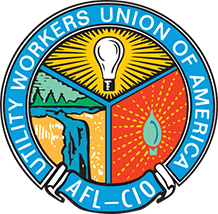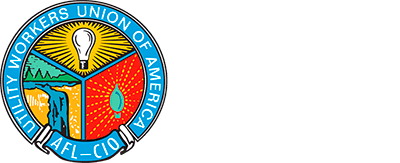 The electrical grid of the United States is one of the most complex systems in the world, powered by thousands of generators and spanning over 600,000 miles of transmission lines. Within this vast network, tens of thousands of substations ensure the efficient and reliable delivery of electricity. In this edition of “How It’s Done,” four UWUA members share insights into their work on these crucial hubs.
The electrical grid of the United States is one of the most complex systems in the world, powered by thousands of generators and spanning over 600,000 miles of transmission lines. Within this vast network, tens of thousands of substations ensure the efficient and reliable delivery of electricity. In this edition of “How It’s Done,” four UWUA members share insights into their work on these crucial hubs.
There are two main types of substations: transmission (275kV and above), where electricity enters and exits the transmission network, and distribution (132kV and below), which use transformers to step down voltage for local use. High voltage lines minimize energy loss over long distances, while lower voltage lines distribute electricity locally. Substations act as intermediaries, connecting the bulk transmission system to the local distribution network, and ensure electricity reaches consumers at the correct voltage levels.
Substations also enable switching operations, allowing for the connection and disconnection of transmission lines or equipment. This is essential for maintenance, fault isolation, and load balancing, ensuring parts of the grid can be serviced without disrupting the overall supply. To further ensure network safety, substations are equipped with protection devices like circuit breakers and relays to detect and isolate faults. Control systems manage these devices and monitor performance. Additionally, substations maintain power quality and stability through voltage regulation and reactive power compensation. Given their essential role, substations are highly secured with fences, security cameras, alarms, and locks.
UWUA members work around the clock to build, inspect, and maintain this vast network of substations, ensuring electricity is transmitted efficiently, safely and reliably from power plants to consumers.
Albert Branch
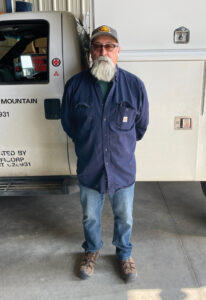 Substation Wireman Foreman
Substation Wireman Foreman
Rocky Mountain Power
Local 127
I’ve been working in the power industry for 34 years. I started at the Jim Bridger Power Plant as a helper and worked my way up over 18 years to Coal-Handling Fuel Man and then to Operations. Eventually, I took an apprenticeship and within three years became a Substation Wireman with Rocky Mountain Power. I’ve now been in this role for 16 years and was honored to serve as a shop steward for Local 127. I’m proud to continue being an active union member.
The primary focus of my job is equipment maintenance and inspection of key substation infrastructure. Rocky Mountain Power provides electricity directly to 1.26 million customers throughout Idaho, Utah, and Wyoming. In southwestern Wyoming, we serve trona mines, gas plants, and all the towns in between. My coverage area includes nearly 60 substations spread across roughly 300 square miles. These include both distribution and transmission substations, with voltages ranging from 120 volts to 500 kilovolts.
Substations contain a wide variety of equipment such as transformers, capacitor banks, regulators, switches, and phase shifters, so balancing safety and efficiency is crucial to keeping them operational. Much of the power carried over the lines is produced in-state at the Jim Bridger Power Plant and wind farms, then processed for transport across the lines in our substations. These substations and power lines also supply several other states, making our operations essential to the electrical infrastructure of the West Coast.
Wyoming’s weather can be brutal at any time of the year, which can bring down a crucial piece of equipment and leave an entire town without power. Since the power grid operates 24/7, an essential part of my job is performing emergency repairs during outages. While I respond to outages as they happen, my main focus is planning jobs and directing preventative maintenance.
An average day involves substation inspections and switching. During an inspection, I patrol the yard to confirm the integrity of our security systems before moving on to the equipment. I review our avian and environmental protection measures, check all the breakers, verify transformer oil levels, and confirm that any pumps and fans are operating properly — essentially testing all the protections and generation equipment throughout the station to ensure optimal performance and keep the power flowing to our customers.
One of the biggest factors in performance is coordination with others, such as linemen, meter-relay technicians, and transmission engineers. When I perform switching jobs, a team of us wiremen work with dispatch, and other teams if needed, to de-energize a precise section of the grid so it can be safely worked on for repairs and upgrades. This is typically performed during low-usage times to minimize downtime for our customers.
Helena Berry
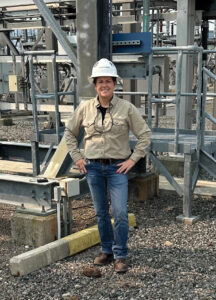 Substation Operator Mechanic
Substation Operator Mechanic
Eversource
Local 369
When I started at Eversource, I was working in customer service at a call center about 10 miles from home. Job postings were included with our weekly paychecks, and I would often apply for positions closer to home. One of those jobs was a substation operator. That was 19 years ago, and I’ve been here ever since.
Training to become a qualified operator took about a year, primarily through on-the-job experience, supplemented with periodic classroom sessions. We reviewed procedures like switching exercises, with instructors taking us into the field to demonstrate tasks. Each classroom session was followed by a test to advance to the next level. This continued until the final operator’s test, a day-long oral exam covering everything from basics to complex scenarios, including practical switching exercises to ensure I could perform them safely. Passing this test made me fully qualified. Nowadays, the process is even more rigorous, involving a three-year apprenticeship.
We still undergo regular retraining on specific topics like first aid and vault rescue and review procedures annually to stay on the Authorized Persons List (APL) for switching dispatch.The field remains predominantly male. I wasn’t the first woman in this role. I started with three other women, and we’re all still here, though in different divisions. There have been a few more women since then, but the field remains largely male-dominated.
My department handles substations in the central Boston area. The work is varied; I never know what I’ll be doing until I report to the office in the morning, where supervisors update us on the district’s status and assign tasks.
Assignments can range from simple station inspections to preventative maintenance or equipment replacement. Depending on the task, I may work alone or with a team. For example, entering a subsurface vault with a 14,000-volt transformer requires a two-person team and extensive safety measures.
During the first few weeks of July, I worked at a station each day with a crew of contractors building a 25-foot wall in our yard. Security is crucial, so our yards must be well-protected. I was there to ensure the contractors worked safely, give them safety briefs and make them aware of hazards.
Weather impacts our workload. After a storm, we may bring in contracted linemen to help with repairs. As someone on the APL, I might work with these crews, acting as the interface between dispatch and contractors to ensure work meets company specifications.
Substation operators work around the clock. I currently work the day shift, but for my first six years, I worked nights. I cover every sixth weekend as part of our 24-hour coverage rotation.
What I like most about the job is the continuous learning and the ever-changing work. Eversource empowers us to work safely and efficiently, making it a fulfilling career.
Brian Dyke
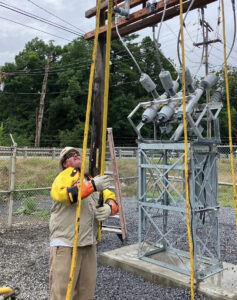 Substation Electrician Crew Leader
Substation Electrician Crew Leader
West Penn Power/First Energy
Local 102
For nearly four years, I’ve led a four-person crew responsible for maintaining and managing 40 substations in the State College, PA, area. These include four transmission stations and various sub-transmission and distribution substations. Anything that happens inside the substation’s fence is our responsibility — maintenance, repairs, testing, and if needed, even constructing an entire substation from the ground up.
Our primary focus is on maintenance and preventive maintenance, which are crucial for the reliability and safety of the power grid. This includes monthly station inspections and regulatory compliance work required by Pennsylvania’s Public Utility Commission (PUC). The PUC mandates yearly maintenance activities on all equipment, ensuring that we keep everything up to standard. Given the vast array of equipment falling under PUC requirements, this is a large part of our work.
A supervisor hands out schedules about a week ahead of time, but storms and equipment failure can disrupt plans, requiring us to be flexible and responsive. After a storm, we may have to perform switching tasks for the line crews. Something as small as a squirrel can take out an entire substation, diverting us to troubleshoot and get customers back online.
My crew’s workweek typically consists of four, 10-hour days, but this summer’s intense storm activity pushed us to work five, 10-hour days to catch up on PUC regulatory tasks.
Ideally, a crew will split into two-person teams to handle maintenance work, with each team traveling to different stations. This division isn’t always possible, however. Most jobs require two Top A qualified workers, who can perform switching, grounding, and work with hot, energized equipment. Currently, only three out of the four members on my crew have this status; the fourth is still an apprentice, so we must adjust accordingly.
Ten years ago, we had six-person crews but we’re now down to four, making it harder to keep up with all the regular work, let alone add new projects like constructing a substation. Since First Energy acquired West Penn Power in 2011, it’s had a tough time recruiting and retaining enough workers to service this part of the state, and we’ve seen high turnover.
I’ve been with the company and a member of Local 102 for 20 years. Before that, I worked at Corning Glass making picture tubes. When the factory closed, I worked as a residential electrician. It’s in my blood — my grandfather and father were both electricians. I did that for a few years and then had a chance to join West Penn Power as a substation electrician apprentice. It’s a five-and-a-half-year journey to achieve our contract’s Top A classification. At this company, every substation electrician must hold Top A status, ensuring we possess the highest level of expertise for our roles.
Ted Bedrowsky
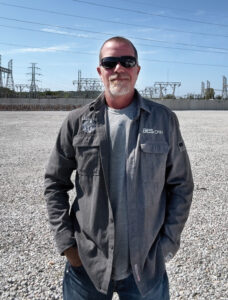 Substation Technician Leader
Substation Technician Leader
AES Ohio (formerly Dayton Power & Light)
Local 175
AES Ohio operates about 160 substations in the Dayton area. My colleague and I are responsible for 17 of these, focusing on maintenance and troubleshooting to ensure reliable service for 550,000 customers.
Preventative maintenance is crucial, especially in the first half of the year when we conduct public utility commission (PUC) compliance work. The Ohio PUC requires every piece of equipment to be taken offline and tested every five years to ensure system integrity.
Routine inspections are another key aspect of our job. Each substation is visited at least once a month for a thorough check. My partner and I split the territory, gathering readings from breakers, checking oil levels, inspecting perimeter fences, and ensuring all grounds are secure. We log all data and observations into a computer system. Some newer substations operate almost autonomously and only require visits when flagged for potential issues.
In July, a severe storm caused circuit lockouts at three substations, affecting about 2,500 customers, including my own home. Storms with 60-70 mph winds often bring down trees on power lines, triggering circuit breaks. System operators monitor the grid 24/7 and quickly dispatch us to affected substations.
Our substations are equipped with Schweitzer relays, which are essentially computers on the breakers that can accurately pinpoint faults. This technology determines if the issue lies within the breaker or the lines coming into or going out of the station. In this storm, the breakers locked out due to line faults. We isolated the problem sections, closed the breakers, and restored power to most customers within an hour and a half.
If a problem arises on a high transmission line feeding the substation, it typically affects the transformer rather than taking out the circuit. For line issues, we de-energize the affected line to allow Local 175’s linemen to safely make the necessary repairs before re-energizing it.
I began my career in 2000 as an operator at Hutchings Station, a coal-fired power plant. After its closure in 2013, I transferred to Stuart Station for a year and a half before moving to the substation department. My training has been mostly on-the-job, with no state requirements beyond a Class A Commercial Driver’s License (CDL) to operate certain equipment. Advancement requires passing a test every two years, and after six years, one is fully qualified for a leadership position.
Currently, I’m leading a five-person crew on a two-month construction job installing new breakers at a substation. This is on top of my regular duties, requiring 8-10 hour workdays and additional time on weekends.
I keep a company truck at home to respond quickly if called in after hours. Officially, I’m on call one week every five weeks, but I often get called even when off duty, especially for issues in my district. My partner and I are protective of our 17 stations and prefer to handle problems ourselves before involving the on-call team.
Being vice president of my local union with 450 members also keeps me busy, with a steady stream of issues to address.
